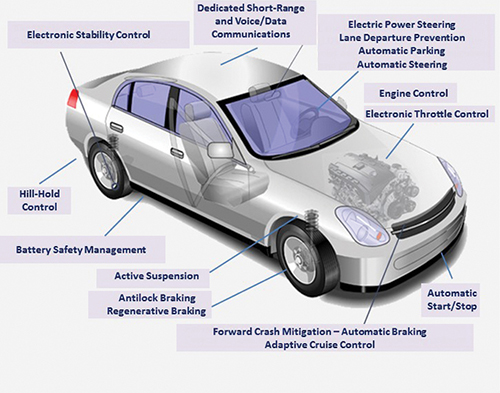Safer and More Reliable Automotive Electronic Control Systems
The number of electronic components used in the construction of motor vehicles has accelerated in recent years. Electronics play a crucial role in developing optimized technological solutions to improve a motor vehicle’s drivability, enhance its safety features, and lower environmental impacts.
“You would be hard-pressed to find a car rolling off a production line that didn’t have dozens of electronic systems,” said Chris Becker, a mechanical engineer at Volpe.
Today’s motor vehicles incorporate an increasingly complex array of electronic systems including sensors, actuators, microprocessors, instrumentation panels, controllers, and displays. Advances in this area have contributed to the development and deployment of safety features such as electronic stability control, tire-pressure monitoring, lane-departure warning, adaptive cruise control, forward crash warning, and automatic braking.

Today’s motor vehicles incorporate an increasingly complex array of electronic systems. These systems have many positive impacts, but can raise vehicle safety assurance issues. (NHTSA image)
This rapid evolution of electronic control and connectivity has increased challenges for vehicle safety assurance. In 2015, the National Highway Traffic Safety Administration (NHTSA) reported that the auto industry recalled over 51 million vehicles because of safety problems—the highest one-year total on record.
NHTSA’s mission is to save lives, prevent injuries, and reduce economic costs due to road traffic crashes. As part of this mission, NHTSA researches methods for ensuring the safety and reliability of safety-critical electronic control systems in motor vehicles.
NHTSA and Volpe have a strong, collaborative relationship in performing engineering analyses to enhance the safety of advanced technologies in vehicles. NHTSA turned to Volpe’s nationally recognized advanced vehicle technology team to assess the safety and reliability of emerging electronic control systems.
The focus of this work was to:
- Define and prioritize safety-critical automotive electronic control systems.
- Assess industry and government safety standards currently being used to ensure the functional safety of motor vehicles.
- Review the state-of-the-art technology of vehicle health management systems.
- Assess vehicle failure response mechanisms and driver information.
The Volpe team performed the research and collaborated with NHTSA’s Electronic Systems Safety Research Division in writing the final report Assessment of Safety Standards for Automotive Electronic Control Systems.
This report is part of a series of publications that describe NHTSA’s initial work in the automotive electronics reliability program. Findings will provide NHTSA and the automotive industry with significant data to address the reliability of evolving safety-critical automotive electronic control systems.
“This report provides NHTSA with the foundation to explore research topics that will ensure safe motor vehicle operation—all in the context of increasingly complex electronic systems, information technology, and wireless connectivity,” Becker said.
